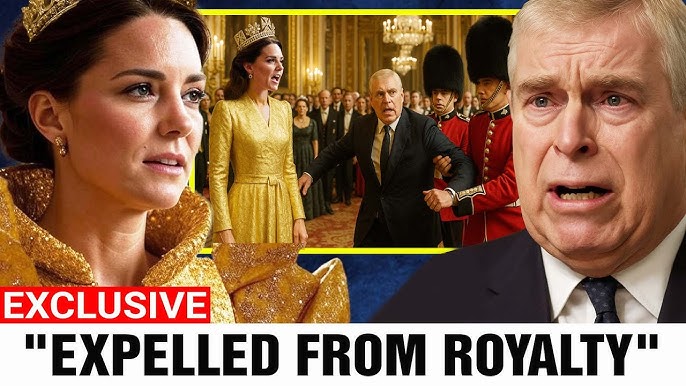Princess Catherine Strips Prince Andrew of Final Titles and Royal Home, Empowered by King Charles

In a move that has sent shockwaves through the British establishment, Princess Catherine, the Princess of Wales, has reportedly taken the unprecedented step of stripping Prince Andrew, Duke of York, of his remaining royal privileges and residence, following full authorization from King Charles III.
The decision marks a historic and symbolic turning point for the modern monarchy—one that solidifies Catherine’s growing influence within the House of Windsor and reaffirms the King’s commitment to restoring the monarchy’s reputation after years of scandal.
A Quiet Storm Behind Palace Doors
According to sources close to Kensington Palace, the matter was settled in a private meeting last week attended by the King, Queen Camilla, Prince William, and Princess Catherine. The meeting, described as “tense but decisive,” concluded with the formal removal of Prince Andrew’s final ceremonial titles and his eviction from Royal Lodge, his long-time home on the Windsor estate.
“The Princess of Wales spoke with calm authority,” one senior aide told The Crown Chronicle. “She was resolute that the monarchy could not move forward while still tethered to its past controversies. Her message was clear: integrity must outweigh bloodline.”
Prince Andrew, 65, who stepped back from public duties in 2019 amid allegations related to his association with Jeffrey Epstein, had retained certain honorary privileges and continued to reside at Royal Lodge despite mounting pressure. His continued presence on royal grounds had long been a point of contention within the family.
King Charles’ Approval—and Delegation of Power
While many expected King Charles to handle the matter personally, insiders suggest it was Princess Catherine who spearheaded the final decision, having gained the King’s explicit trust to oversee sensitive internal reforms.
“His Majesty believes Catherine represents the future of the Crown,” explained a royal historian, Dr. Edmund Ryle. “By delegating this authority to her, he signals not just confidence in her judgment, but also the beginning of a quieter, generational transition within the monarchy.”
Royal observers note that Catherine’s growing authority within the royal household is no accident. Since the King’s recent health challenges earlier this year, the Princess has taken on an increasingly active leadership role, coordinating charitable initiatives, overseeing public image strategy, and even mediating family disputes.
The End of an Era for Prince Andrew
Prince Andrew was reportedly informed of the decision in a brief private audience with the King at Buckingham Palace. A source close to the Duke described him as “visibly shaken” and “deeply saddened” by the outcome.
“Andrew believed he would live out his days quietly at Royal Lodge,” the source said. “He never imagined being forced to leave. This feels like exile.”
According to palace insiders, Andrew will be relocated to a smaller residence on the Sandringham estate. His remaining staff have been dismissed, and his royal security detail will be reduced to a private arrangement.
The symbolic stripping of his last honors—including his role as Vice Admiral and his status as Counselor of State—marks the final chapter in a slow but deliberate process of distancing the monarchy from one of its most controversial figures.
A Calculated Act of Renewal
Analysts are calling Catherine’s intervention a defining moment in her evolution from royal consort to de facto stateswoman. Long admired for her diplomacy and restraint, the Princess of Wales has shown a new side—one of strategic firmness.
“This was a masterclass in controlled reform,” said British commentator Annabelle Grant. “She has managed to reinforce the monarchy’s moral authority without causing open conflict. It’s a careful balancing act—and she’s done it flawlessly.”
Behind the scenes, Catherine is believed to have framed her argument around the monarchy’s long-term credibility. With Prince William preparing to inherit the throne, and the couple’s popularity at record highs, protecting the royal brand has become a generational mission.
“Catherine is deeply aware of the power of perception,” another palace aide said. “She knows that the public must see the monarchy as ethical and forward-looking. This decision wasn’t about punishment—it was about preservation.”
Public Reaction: Divided but Respectful
Public opinion across Britain has been mixed but largely respectful. While some view the move as harsh, others see it as overdue.
“I think it’s about time someone cleaned up the royal mess,” said Jane Holloway, a London shopkeeper interviewed near Kensington Palace. “If Catherine’s the one doing it, good for her. She’s proving she’s not just a figurehead.”
On social media, hashtags such as #NewMonarchy and #CatherineTheDecisive trended overnight, with many users praising the Princess for her “quiet strength” and “modern leadership.”
Still, not everyone is convinced. Critics of the monarchy have argued that the move, while symbolically significant, is ultimately a calculated public relations maneuver. “It’s a reshuffling of privilege, not a revolution,” one commentator wrote in The Guardian.
The Future of the House of Windsor
For the monarchy, the event represents both an ending and a beginning. With Prince Andrew’s chapter effectively closed, King Charles and Princess Catherine are steering the royal institution toward a leaner, more transparent model—one that prioritizes duty over entitlement.
Rumors persist that Catherine is already drafting new guidelines for the conduct and public roles of minor royals, a move expected to take effect within the next year.
“The monarchy has survived for centuries by adapting,” said historian Ryle. “Catherine’s actions show she understands that adaptation is no longer optional—it’s essential.”
As the sun sets over Windsor, Royal Lodge’s gates are reportedly being sealed for renovation. Whether Prince Andrew’s departure marks redemption or simply retreat remains unclear. But one thing is certain: under Princess Catherine’s watch, the Crown has found a new kind of strength—rooted not in tradition alone, but in accountability.
For the first time in generations, the monarchy’s future seems firmly guided by a woman’s steady hand.